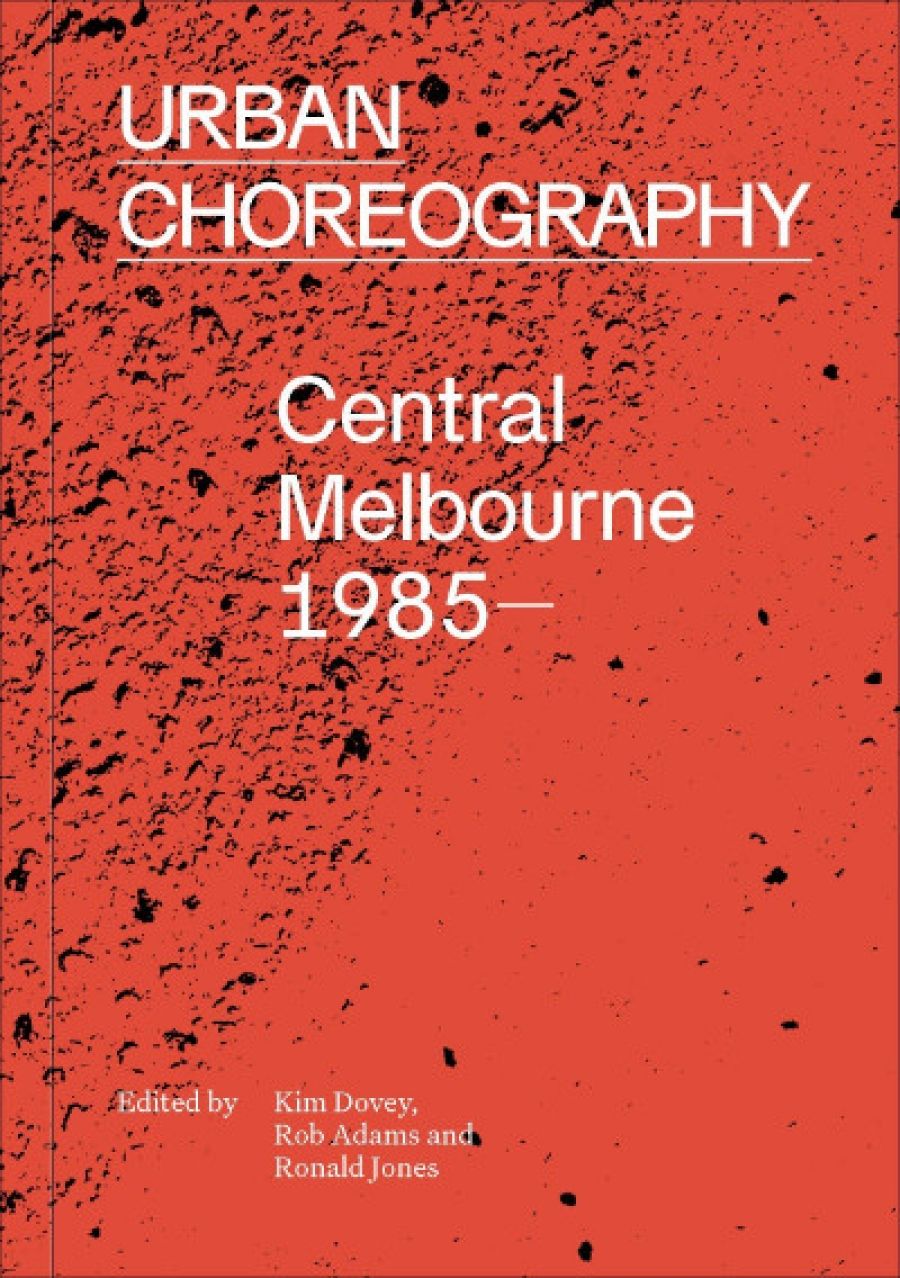
- Free Article: No
- Contents Category: Environmental Studies
- Custom Article Title: Sara Savage reviews 'Urban Choreography: Central Melbourne 1985–' edited by Kim Dovey, Rob Adams, and Ronald Jones
- Custom Highlight Text:
In her influential 1961 text The Death and Life of Great American Cities, American-Canadian urban activist Jane Jacobs famously characterised the complex order of a successful city as ‘an intricate ballet’. The ‘dance’ of a thriving city sidewalk, says Jacobs, bucks trends of uniformity and repetition in favour of improvisation, movement, and change.
- Book 1 Title: Urban Choreography
- Book 1 Subtitle: Central Melbourne 1985–
- Book 1 Biblio: Melbourne University Press, $44.99 pb, 319 pp, 9780522871661
Clearly, the editors (Dovey, Jones, and Rob Adams) share Jacobs’s belief that spontaneity and unpredictability are integral elements of any flourishing city. They also believe that urban transformation should be slow: at the book’s launch in early 2018, Dovey (professor and former head of Architecture and Urban Design at the University of Melbourne) even commented that an early working title for the book was ‘Incremental Urbanism’, referring to the importance of gentle reshaping over sudden, reactionary urban change. In the chapter ‘Designing and Framing Public Space’, Melbourne architect and public realm expert Peter Elliott reinforces this sentiment: ‘Those parts of a city that undergo gradual piecemeal change, rather than radical surgery, retain more layers of history and memory.’ Urban Choreography is a book that attempts to peel back some of these layers to map the gradual, yet dramatic, shift in Melbourne’s city centre from the mid-1980s until today.
With the pervasiveness of a Coles jingle, local media love to remind Melburnians that their city’s population has nearly trebled in the last fifty years and is set to double again by 2050. Adams, Dovey, and Jones aren’t interested in limiting this growth; instead, Urban Choreography reckons with the double-edged sword of population density and the Jacobsian notion that for this particular dance to effectively play out in a city, mixed primary use and walkability are essential. (In his 2016 book Urban Design Thinking, Dovey frequently refers to ‘DMA’: the trinity of density, mix, and access ‘that comprises a structural core that is necessary, although insufficient, for the emergence of urban intensity’.) At its heart, Urban Choreography is a story of increasing density and the way Melbourne has handled this continuing challenge in recent years.
In the opening chapter, Danish urbanist and architect Jan Gehl reflects on his forty-year relationship with Melbourne – from early investigations on street life in inner-city residential areas to the long-running research collaboration with City of Melbourne, Places for People, which surveyed the central city’s public life in 1994 and again in 2004. In ‘Taking Council’, Lecki Ord, a former lord mayor of Melbourne, pays tribute to the community activism led by social and environmental planners Ruth and Maurie Crow, champions of functional mix and the drivers behind a number of instrumental plans in the early 1970s. Elsewhere, urban economist and planner Marcus Spiller details the effects of neoliberal reforms in Melbourne in ‘Economic Change and Urban Design’ (complete with a seemingly straight-faced observation that 1970s Melbourne looked and felt ‘provincial’), while in ‘A City with Soul’ former Federation Square CEO Kate Brennan considers Melbourne’s changing relationship with public art (‘no longer an embellishment of successful urban design and planning but an essential component of it’).
 Docklands from the west, 1988
Docklands from the west, 1988
 Docklands from the west, 2017
Docklands from the west, 2017
One valuable contribution comes from co-editor Ronald Jones, landscape architect and urban designer, whose comprehensive chapter – clear-sighted and refreshingly lacking in spin – recounts some pivotal moments in Melbourne’s recent urban history (including those in which he played a major part, like Birrarung Marr and the pedestrianisation of Swanston Street). Equally compelling is Dovey’s thoughtful series of interviews with Adams, conducted over several months at Mario’s in Fitzroy. With a career spanning sixteen lord mayors and a chief commissioner, Adams is arguably best placed to tell the tale of Melbourne’s many recent transformations, and the conversational format of this chapter allows for more frank dialogue and candid reflections than the rest of the book.
There are some telling moments in ‘The Marios Talks’. When discussing the network of laneways for which Melbourne is now well-known, Adams makes a distinction between street art (‘a positive thing’) and tagging (‘mindless’), as if the two forms of graffiti aren’t fundamentally entwined. For all the fuss made in Urban Choreography about the rights of people to reclaim public space, it’s clear where the line is drawn (or indeed aggressively removed) by the City of Melbourne. (Why not instead address the many factors that might lead to an excess of tagging in the city?) Similarly jarring are Adams’s thoughts on architectural and artistic acknowledgements of Traditional Owners in the city: ‘Clearly, this is a relationship we still need to better understand, and be prepared to listen to and discuss more, if we are to find long-term meaningful positions,’ he says – and he’s right – but if this is so, why wasn’t the topic given more airtime inside this otherwise impeccably thorough volume?
 Southbank, 1983
Southbank, 1983
 Southbank, 2017
Southbank, 2017
True to its open-ended title, Urban Choreography: Central Melbourne 1985– culminates with a nod to the future: what next for Melbourne’s urban adagio? If an updated edition were to be published in another thirty years’ time, what will we have learned? And how might recent developments – the Metro Tunnel; the proposed Apple store in Federation Square; the Public Housing Renewal Program; or the Andrews government’s ‘anti-association’ laws – fit into the story? Urban Choreography is not simply an execise in hindsight, nor is it just a reminder of the importance of good local (and state) governance: it’s a salient expression of the inherent power of urban design – slow, fast, Jacobsian, or otherwise – to shape our daily experiences in the city.


Comments powered by CComment